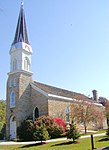Beth Jacob Congregation (Mendota Heights, Minnesota)
Conservative synagogues in Minnesota
Beth Jacob Congregation is a Conservative Jewish synagogue located in Mendota Heights, Minnesota, United States. It was founded in 1985 and has a membership of 400 families. Beth Jacob is a community of Jews who come together to nurture relationships with God and each other. It is a Conservative synagogue that values Torah (study), Avodah (reverential service) and Gemilut Hasadim (acts of loving kindness). Men, women and children have equal opportunity to be part of the community.
Excerpt from the Wikipedia article Beth Jacob Congregation (Mendota Heights, Minnesota) (License: CC BY-SA 3.0, Authors).Beth Jacob Congregation (Mendota Heights, Minnesota)
Victoria Curve,
Geographical coordinates (GPS) Address Phone number Website Nearby Places Show on map
Geographical coordinates (GPS)
| Latitude | Longitude |
|---|---|
| N 44.885 ° | E -93.151388888889 ° |
Address
Beth Jacob Congregatoin
Victoria Curve 1179
55118
Minnesota, United States
Open on Google Maps









